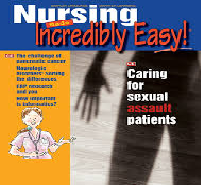Nursing Evidence Based Practice Articles Order Instructions: The writer will have to read each of this articles and react to them by commenting, analyzing and supporting with 2 relevant articles per paragraph.

The writer will have to read carefully before giving constructive comments on the article. the writer cannot just say ” I agree or you are correct” he must give a brief explanation for his rational for criticizing or supporting the facts. The writer should write a one paragraph of at least 150 words using 2 pear review articles per paragraph to support his facts. APA and in text citation must be use as each respond to the two articles must have in text citations. The writer will have to use an article to supports his comments in each of the article. Address the content of each article below in a one paragraph each, analysis and evaluation of the topic, as well as the integration of 2 relevant resources per paragraph.
Nursing Evidence Based Practice Articles Sample Answer
Article 1
Awesome post! Evidence Based Practice (EBP) is an important learning tool that can be used in clinical settings to promote awareness among patients (Buysse, et al, 2012). This model involves Evidence-Informed Decision Making, which to me is a vital method that healthcare practioners should be equipped with for effective integration of quality research evidence and with information regarding clinical context, preferences, and resource.
Nurses should establish proper avenues promote clinical excellence during their practice (Schneider, et al, 2013). Such avenues will help them collect vital evidence that they can use in making brilliant decisions. For instance, the author of this post has chosen going through the documents of admitted children and finding out how many are immunized, collecting parents opinions and feedbacks on immunization, documenting parental education on immunization, and monitoring any patients that could have been admitted for preventable diseases.
With this information, the nurse will be in a better position of determining the quality outcomes of the immunization that children receive in their clinic, what factors make some parents not to present or delay presenting their children for immunization, and the prevalence of preventable diseases in the surrounding region. Positive interventions will then be undertaken to ensure that the diseases have been eliminated and the public has sufficient knowledge regarding these diseases.
Article 2
Healthcare officials not only prescribe, administer, and monitor patients but also are actively involved in research that promotes quality healthcare delivery and positive patient outcomes (Buysse, et al, 2012). For instance, they can use the change model to determine what needs to be changed, uncovering appropriate evidence on the subject matter, and scrutinizing the evidence critically.
According to Bright et al. clinical settings play a central role in providing research data (Bright, et al, 2012). The data is filled and updated accordingly in computers and therefore, it is easily accessible for research. For instance, research on poor antibiotic efficacy can be conducted. Data on previous drug and medical histories of patients can be obtained from hospital computers; the nurse should also enquire on patient compliance, and educate the patient on importance of drug compliance. This will aid in preventing antibiotic resistance which arises due to mutation of bacteria as a result of non-compliance and medical errors (Li, et al, 2015). After putting in place suitable interventions, the nurse should follow and confirm the progress of the project.
Nursing Evidence Based Practice Articles References
Bright, T. J., Wong, A., Dhurjati, R., Bristow, E., Bastian, L., Coeytaux, R. R., … & Wing, L. (2012). Effect of clinical decision-support systems: a systematic review. Annals of internal medicine, 157(1), 29-43.
Buysse, V., Winton, P. J., Rous, B. E. T. H., Epstein, D. J., & Lim, C. I. (2012). Evidence-based practice. Zero Three, 32, 25-29.
Li, X. Z., Plésiat, P., & Nikaido, H. (2015). The challenge of efflux-mediated antibiotic resistance in Gram-negative bacteria. Clinical microbiology reviews, 28(2), 337-418.
Schneider, Z., & Whitehead, D. (2013). Nursing and midwifery research: Methods and appraisal for evidence-based practice. Elsevier Australia.




